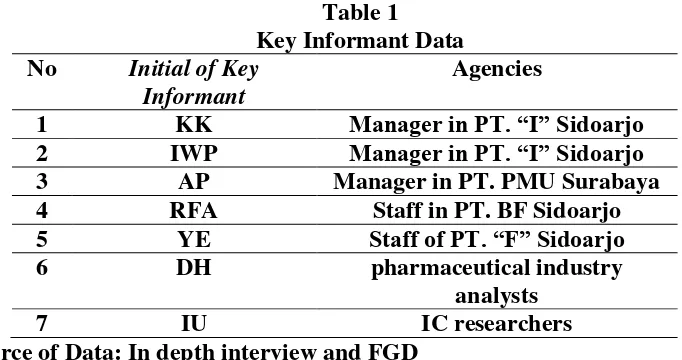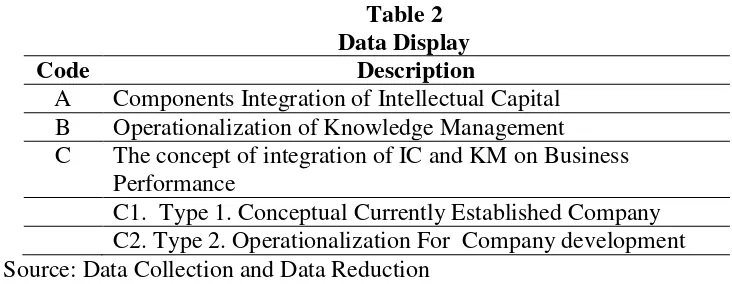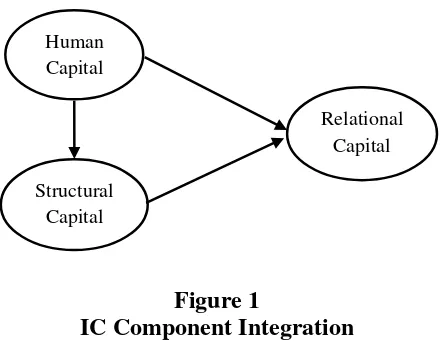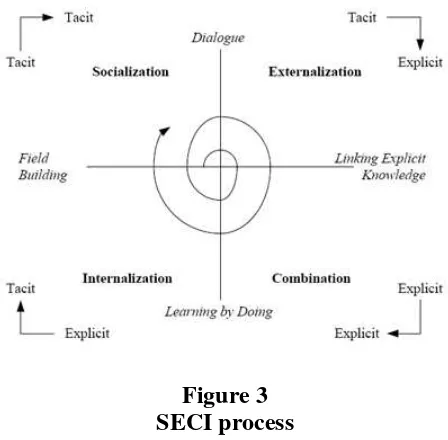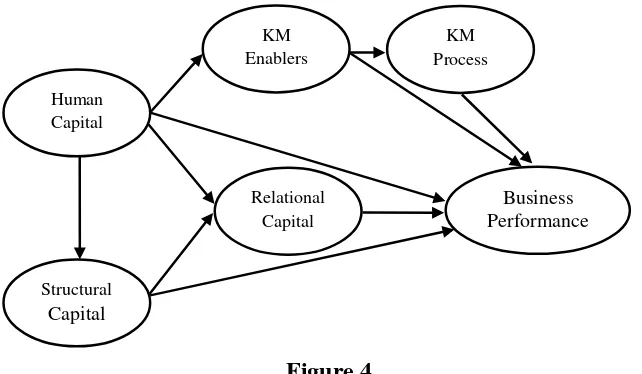THE CONCEPT OF INTEGRATION OF INTELLECTUAL CAPITAL AND KNOWLEDGE MANAGEMENT AND ITS RELATIONSHIP
WITH BUSINESS PERFORMANCE
Sigit Hermawan
Faculty of Economics, University of Muhammadiyah Sidoarjo Email: [email protected]
ABSTRACT
The objective of this research is to develop the concept of integration of Intellectual Capital (IC), Knowledge Management (KM) and its relationship with the pharmaceutical company's business performance. The basic theory underlying this integration is the resource-based theory and the knowledge-based theory. Both theories are important in this research because of the increasing role of intangible resources in the era of knowledge economy nowadays.
This research is conducted with the interpretive accounting research approach. The data are collected by in depth interviews, Focus Group Discussion (FGD), and documentation. The validity of the data is tested by credibility and transferability tests. The data analysis is carried out during the data collection process with the stages of data collection, data reduction, the data display, and conclusion.
The results show that there are two concepts of integration of IC and KM on business performance. The first concept is a theoretical concept that is constructed from a variety of theories and preliminary research, and the second concept is applicable concepts which are prevalent in a variety of pharmaceutical companies. The first begins with the concept of Human Capital (HC) as the central role which will form the Structural Capital (SC), Relational Capital (RC), Knowledge Management enablers (KME), and business performance. Furthermore, the SC will contribute to the RC and business performance. RC will play a role on business performance. KME will establish Knowledge Management Process (KMP) and business performance. Finally, KMP will contribute to business performance. The second concept begins with KME which will form the next KMP and KMP will be significant to the successful establishment of HC, SC and RC. Furthermore, HC will play a big role to SC, RC, and business performance. SC will be crucial to RC and business performance, as well as the RC will be instrumental in the success of the business performance.
Keywords: Intellectual Capital, Knowledge Management, Business Performance, Interpretive Accounting Research.
INTRODUCTION
(KM) on business performance and effectiveness of the organization (Choi, 2002; Kasim, 2008). It means both of them (IC and KM) has an important role in a variety of activities in corporate both strategic and operational activities.
But the important role of IC and KM is not yet widely known, has not been identified, has not yet managed even utilized by pharmaceutical companies in Indonesia. Research of Hermawan (2012) states that the pharmaceutical company managers do not know and do not understand the important role of the IC in the daily operational works and also its relation to business performance improvement. By not understand the concept of IC by the pharmaceutical company managers feared would impact on daily activities and business performance of the company. The results of these studies reinforce the results of previous studies by Sampoerno (2007) which states that the management of IC by pharmaceutical companies in Indonesia is still very weak. Having regard to the need for the role of the IC and KM then they really need to be integrated (Hermawan, 2011a). The integration of IC and KM is very necessary because it demands a new strategy in the era of knowledge economy. Strategies that have so far not been fully used knowledge, whereas the business practices and the world economy today is very demanding innovation and intellectually-based creativity, knowledge, and technology, especially for the companies highly intensive ICs, such as pharmaceutical companies.
The integration of IC and KM is needed because of the process of business transformation from dependence on physical assets to intangible assets empowerment. This business transformation is what is currently being done by many pharmaceutical companies in Indonesia. The integration of IC and KM will further empower the human resources (HR) of the company not only as a human resource but rather on human capital (HC). With regard to the importance of integration of IC and KM, this study aims to develop the concept of integration of IC and KM and its relation with the business performance of pharmaceutical company.
METHOD
This study was conducted with the interpretive accounting research (IAR) approach or more specifically as an interpretive research (IR) in management accounting (Lukkaa and Modell, 2010). Indeed, according to Harris and Durden (2011) that related to intellectual capital or knowledge flow also is in the domain of management accounting research group of intellectual resource management. This study also discusses the management of IC and KM as a strategic relation with the performance of the business and not discuss IC and KM from a financial perspective. As paper of Hermawan(2013)that IC research can be divided into two namely non-financial IC research and non-financial IC research. This research study include into the category of non-financial IC.
Table 1 Key Informant Data No Initial of Key
Informant
Agencies
1 KK Manager in PT. “I” Sidoarjo
2 IWP Manager in PT. “I” Sidoarjo
3 AP Manager in PT. PMU Surabaya
4 RFA Staff in PT. BF Sidoarjo
5 YE Staff of PT. “F” Sidoarjo
6 DH pharmaceutical industry
analysts
7 IU IC researchers
Source of Data: In depth interview and FGD
The validity test of the data was carried by the test of credibility and transferability (Senton, 2004). Credibility test was conducted by triangulation test. Transferability test is done by providing information as possible on research reports related to the research process as parsimony that make simple things complicated. In qualitative research, the researcher could not guarantee the results of his research can be applied to other studies, but the task is to explain the stages of qualitative research and the research process in detail and clearly so the other qualitative researcher can understand it.
Data analysis was carried out during the data collection process with the stages of data collection, data reduction, data display, and conclusion (Miles and Huberman, 1984). Phase of data collection was done by conducting interviews and documentation. The collected data is the responses of the informants through in depth interviews, the data of the FGD participant comments, and documentation as HC qualification required by the pharmaceutical company, CPOB regulations, and policies related to pharmaceutical company marketing system. At the time of data collection stage, researchers are also collecting data while testing the validity of the data that is the credibility test with triangulation. Triangulation tests conducted consisting of test methods, triangulation of data sources, and theory triangulation.
Data reduction is done by selecting the data that has been collected to look for the patterns and the same opinion about the themes of the research that has been determined. At this stage of the data reduction data were discarded and not used due to stray from the themes or patterns defined in the focus of research. The result of the data reduction is the data display. Based on the data display here the results of research began to appear and can be decomposed into a research report. The final stage of the process of data analysis is the conclusion or inference. At this stage, researchers continue to make the process of collecting data until the data is completely saturated and researchers believe that the results of the study are in accordance with the purpose and focus of research.
RESULTS AND DISCUSSION
Table 2 Data Display
Code Description
A Components Integration of Intellectual Capital B Operationalization of Knowledge Management C The concept of integration of IC and KM on Business
Performance
C1. Type 1. Conceptual Currently Established Company C2. Type 2. Operationalization For Company development Data Source: Data Collection and Data Reduction
A. Integration Components of Intellectual Capital (IC)
Integration of IC components shown in Figure 1. Components IC consist of human capital (HC), structural capital (SC), and relational capital (RC). HC has a central role for the formation and development of the SC and RC. HC in the form of employees who have competence in the field of pharmaceuticals, education level, experience, professionalism, and commitment to work. IC component is formed by HC SC and RC. SC consists of the organizational culture, organizational structure, and information systems and technologies. While the RC consists of the marketing system capabilities, product innovation, customer relationships, marketing strategy and relationship with the community.
According to key informants, that HC has a fairly central role associated with the SC and RC. For example, the formation process of the production of drugs which pharmaceutical companies must use the standard GMP (Good Manufacturing Practice). It required a pharmacist in accordance with FDA standards. This suggests a central role of the HC to SC. While the role of the HC in the RC component is the provision of marketing or medical representative (med rep). Med rep power experienced and trained very helpful marketing pharmaceutical products in particular patent medicines and ethical drugs. About the central role of HC is consistent with research Herman (2013) and Kamath (2008).
Figure 1
IC Component Integration
B. Integration of Knowledge Management (KM)
This study divides KM into two parts, namely KM enablers and KM process. KM enablers are factors that are specifically to be the key infrastructure that supports the successful development of KM. An example is the strategy and leadership, organizational culture, information technology, and organizational incentive systems. This is consistent with the study of Ho (2009), Choi (2002), and Gold et al (2001). While the KM process is operationalization of KM through the process of SECI (Socialization, externalization, Combination, and Internalization) (Wahono, 2008). KM integration Indicated by the KM enablers contribute to the KM process as Figure 2 This means that the KM enablers be the deciding factor for the success of the operationalization of KM because KM enablers will be associated with the development of the existing infrastructure in the organization. Infrastructure supported by culture and technology will result in activities that support employee knowledge. For example is a culture of collaboration. It will be helpful to make effective knowledge management (Gold et al, 2001). Collaborative interaction such as open dialogue, social interaction, and other activities that can create organizational knowledge. Exchange of knowledge among members of the company organization is a prerequisite for creating knowledge (knowledge creation).
Research of Choi (2002) is one of studies that used a collaborative culture as a dimension associated with knowledge creation. Besides other dimension is the culture of learning, as well trust. In addition to the cultural dimension, research Choi (2002) also use the structure (centralization and formalization), people (T-shaped skills), and IT (IT support) as a dimension of knowledge management enablers for variables associated with knowledge creation process. The results showed that the culture and centralization contribute to knowledge creation process. In this study, knowledge creation process has same meaning with knowledge management process.
Human Capital
Structural Capital
Figure 2 Integration of KM
Meanwhile, operationally, the process of SECI is shown by Figure 3. Socialization is the process of changing from tacit knowledge to tacit knowledge. Example is the idea, knowledge, and experience possessed by the senior employee is transferred to a junior employee. Meanwhile, externalization is the process of change from tacit knowledge to explicit knowledge. For example, senior employees who have had the experience required to create a variety of regulations or Standard Operating Procedure (SOP) for the selection of raw materials and then it is recorded. The next combination is the process of changing from explicit knowledge to explicit knowledge. For example, there are regulations on GMP rules again made more technical in the company and the regulation posted. The last phase is the Internalization, the process of change from explicit knowledge to tacit knowledge. For example, the new regulations were then given to the employee and the employee is required to change it into the unseen knowledge (inspiration).
Figure 3 SECI process
C. The concept of integration of IC and KM on Business Performance
Based on the results of the interviews both in depth interviews, focus groups, and triangulation theory analysis obtained the results that there are two concepts of integration of IC and KM on business performance. The first concept, as well as figure 4, states that the HC has a central role to all existing variables. HC contributes to SC, RC, business performance, and KM enablers. According to key informants that the first concept is more conceptual and performed at the beginning of the establishment of the company. This is done because of the central role of HC is so great.
KM Enablers
As in figure 4 that the IC consists of HC, SC, and RC. KM consists of KM enablers and KM process. IC, either individually or group acts on improving business performance pharmaceutical companies. Likewise, KM, either individually or groups also play a role in performance improvement business performance. Meanwhile specifically HC role in the formation of KM enablers. The results of this study support such studies that have been done before, such as research Sharabati, et al (2010), Chen et al (2004), Cabrita and Bontis (2007), Gold et al (2001), Choi (2002), Zhou and Fink (2003), and Hsu (2006).
Figure 4
The concept of IC and KM on Business Performance (Type 1)
The second concept, such as figure 5, states that the greatest role is KM enablers, KM Process, which will then determine the role of the IC component (HC, SC, and RC), and the three components of the IC will contribute to the improvement of the business performance of the pharmaceutical company. According to the key informants that this second concept is the concept that is used when a company already in early stages of development. This proficiency level can be seen in the role of KM in the IC. This is the opposite of the first concept.
In the second type, that KM as determining factors of management IC. KM enablers consisting of strategy and leadership, organizational culture, information technology, and organizational incentive systems will form the SECI process as an indicator of the KM process. This is consistent with studies (Gold et al, 2001) and Choi (2002). Next by the SECI process will facilitate the process of improving the overall performance of the IC either individually or IC also consisting of HC, SC, and RC. Finally, the IC will be able to improve the performance of business performance, either individually or in groups as in the case Huang and Hsueh (2007), Bontis et al (2000), Cabrita and Bontis (2008), and Cabrita et al (2007), Wang and Chang (2005), Sharabati, et al (2010), Chen et al (2004).
Structural Capital
Human Capital
Relational Capital
Business Performance KM
Process KM
Figure 5
The concept of IC and KM on Business Performance (Type 2)
CONCLUSION
Conclusions of this study are that the concept of integration of IC and KM can be divided into two concepts that are when the company in the early days as a stand rely HC as central role. The role of the HC will affect SC, RC, KM enablers, KM process, and business performance. Meanwhile, the second concept is the concept in which the company has been in operation and under development. By the basis, it is needed of KM enablers that play a role in the KM process and then act on the IC component (HC, SC, and RC) that will eventually effect on improving business performance.
REFERENCE
Belkaoui, Ahmed Riahi. 2003. Intellectual Capital and Firm Performance US Firm. A Study of The Resource Based and Stakeholders View. Journal of Intellectual Capital. Vol 4 No. 2. Pp 215-226.
Bontis, Nick. 1998. Intellectual Capital: An Exploratory Study That Develops Measures and Models. Management Decision. Vol 36 No 2, pp 63-76.
Bontis, Nick., William Chua Chong Keow., and Stanly Richardson. 2000. Intellectual Capital and Business Performance in Malaysian Industries. Journal of Intellectual Capital. Vol 1 No 1, pp 85-100.
Bontis, Nick and Jac Fitz Enz. 2002. Intellectual Capital ROI : A Casual Map of Human Capital Antecedents and Consequents. Journal of Intellectual Capital. Vol 3 No 3, pp 223 – 247.
Cabrita, Maria do Rosario, and Nick Bontis. 2008 ‘Intellectual Capital and Business Performance in The Portuguese Banking Industry’, Int. J. Technology Management, Vol. 43, Nos. 1-3, pp.212–237.
Cabrita, Maria do Rosario., Jorge Landeiro de Vas., and Nick Bontis. 2007 Modelling the Creation of Value from Intellectual Capital: A Portuguese Banking Perspective,
Int. J. Knowledge and Learning. Vol. 3, Nos. 2/3, pp. 266 – 280.
Chen, Jin., Zhaohui Zhu., and Hong Yuan Xie. 2004. Measuring Intellectual Capital: A New Model and Empirical Study. Journal of Intellectual Capital. Vol 5 No 1, pp 195 – 212.
KM Enablers
KM Process
Human Capital
Structural Capital
Relational Capital
Choi, Byounggu. 2002. Knowledge Management Enablers, Processes, and Organizational Performance: An Integration and Empirical Examination.
Dissertation. Korea Advanced Institute od Science and Technology.
Gold, Andrew H., Arvind Malholtra., and Albert H Segars. 2001. Knowledge Management : An Organizational Capabilities Perspective. Journal of Management Information System / Summer., Vol 18 No 1, pp 185 – 214.
Harris, J., dan C. Durden. 2011. Directions In Management Accounting Research: An Analysis of Contemporary Issues and Themes. Eprints.jcu.edu.20674 1. Asia Pasific Conf Paper: 1-21.
Hermawan, Sigit. 2011a. The Integration of Intellectual Capital and Knowledge Management to Improve the Business Performance and Achieve the Competitive Advantage. Proceeding International Seminar, Strategic Management and Performance in Private and Public Sector, at Economics and Business Faculty of Hasanuddin University, Makassar, August 22, 2011.
. 2011b. Management Accounting Practice and Business Performance. Overview of Intellectual Capital Perspective. Journal of OPTIMAL. FE Bekasi Islamic University. Vol 5 No. 2-September.
.2011c. Optimization of Intellectual Capital to Improve Business Performance HPI Batik and Win Competition in CAFTA. Proceeding. National Seminar of FEB University of Muhammadiyah Malang, 1 October 2011.
____.2012. Roles, Management, Intellectual Capital and Empowerment, And Repair Business Practices Pharmaceutical Industry. Dissertation. Faculty of Economics and Business. University of Airlangga Surabaya.
Hermawan, Sigit dan Silvia Herlina. 2013. Identification and Interaction interpretive study of Intellectual Capital on Company Performance. Journal of The Review of Accounting and Finance. Accounting Department FEB UMM. Vol 3 No. 1-April. Hermawan, Sigit. 2013. Meaning of Intellectual Capital Perspective of the Role Theory
and the Resource-Based Theory. Journal of EQUITY. STIESIA Surabaya, Vol 17 No 2, pp 256 - 275.
Hsu, Hsiu-Yueh (Sonya). 2006. Knowledge Management and Intellectual Capital.
Dissertation. Carbondale, USA : Southern Illinois University.
Ho, Chin-Tsang. 2009. The Relationship Between Knowledge Management Enablers and Performance. Industrial Management and Data System. Vol 109 No 1, pp 98 - 117.
Huang, Chung-Fah and Hsueh, Sung-Lin. 2007. A Study On The Relationship Between Intellectual Capital And Business Performance In The Engineering Consulting Industry: A Path Analysis. Journal of Civil Engineering and Management. Vol 13, No 4, 265–271.
International Federation of Accountants (IFAC). 1998. The Measurement And Management of Intellectual Capital : An Introduction. New York. USA.
Kamath, G. B. 2008. Intellectual Capital and Corporate Performance in Indian Pharmaceutical Industry. Journal of Intellectual Capital9(6): 684–704.
Kasim, Raja Suzana Raja. 2008. The Relationship of Knowledge Management Practices, Competencies and Organizational Performance of Government Departments in Malaysia. World Academy of Science, Engineering and Technology, pp 53 - 59. Khalique, M., J. A. N. Shaari., A. B. M. Isa, dan A. Ageel. 2011. Role of Intellectual
Capital on the Organizational Performance of Electrical SMEs in Pakistan.
Lukkaa, K., dan S. Modell, 2010. Validation in Interpretive Management Accounting Research. Accounting, Organizations and Society, 35: 462-477.
Mageza, P. Z. 2004. Intellectual Capital As A Creator of Wealth and Shareholder Value For An Organization. Short Dissertation. Rand Afrikaans University. USA.
Marshall, M. N. 1996. Sampling for Qualitative Research. Family Practice an International Journal 13(6).
Miles, M. B., dan A. M. Huberman. 1984. Qualitative Data Analysis. Sage Publication Inc. USA.
Moon, Yun Ji, and Hyo Gun Kym. 2006. A Model for The Value of Intellectual Capital.
Canadian Journal of Administrative Sciences; Sep 2006; 23, 3; ABI/INFORM Global. pg. 253.
Sampoerno, 2007. The Capabilities of Technology and Strengthening of R & D : Challenges of The Pharmaceutical Industry in Indonesia. Pharmacy Magazine Indonesia. 18(4): 199–209.
Senton, A. K. 2004. Strategies for Ensuring Trustworthiness in Qualitative Research Project. Education for Information 22: 63-75.
Sharabati, Abdel-Aziz Ahmad., Shawqi Naji Jawad., and Nick Bontis. 2010. Intellectual Capital and Business Performance in The Pharmaceutical Sector of Jordan.
Management Decision. Vol 48. No. 1. pp. 105 – 131.
Shih, Kuang Hsun., Chia JungChang., and Binshan Lin. 2010. Assessing Knowledge Creation and Intellectual Capital in Banking Industry. Journal of Intellectual Capital. Vol 11, No 1, pp 74-89.
Wahono, Romi Satria. 2008. Knowledge Management and its Practically Tips. http://romisatriawahono.net/2008/05/06/. Accessed 25 April 2010. Accessed 19.15 WIT (Western Indonesian Time).
Wang, Wen-Ying., and Chingfu Chang. 2005. Intellectual Capital and Performance in Casual Models. Evidence from the Informational Technology Industry in Taiwan.
Journal of Intellectual Capital. Vol 6 No 2, pp 222 – 236
